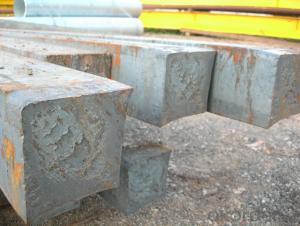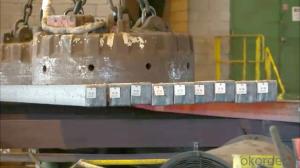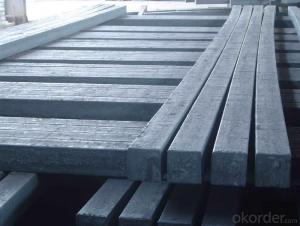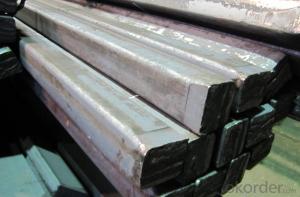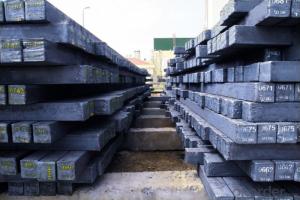Hot Rolled Steel Billet 3SP Standard 160mm
- Loading Port:
- Shanghai
- Payment Terms:
- TT OR LC
- Min Order Qty:
- 100 m.t.
- Supply Capability:
- 10000 m.t./month
OKorder Service Pledge
OKorder Financial Service
You Might Also Like
Structure of Hot Rolled Steel Billet 3SP Standard 160mm

Description of Hot Rolled Steel Billet 3SP Standard 160mm
Prepainted Rolled steel Coil is a kind of coated steel coil/sheet. With the cold rolled steel of different strength and thickness as substrate, it is produced through applying Al-Zn coat on both faces by hot dip process. In its coating, Al accounts for about 55%, Si 1.6%, while the remaining is Zn. Aluminum zinc coils enjoys both the physical protective feature and durability of Al and the electrochemical protective property of Zn. And its surface has bright silver color and regular embossed-like figure, which are highly decorative. RAL Scale Z35 Prepainted Rolled Steel Coil for Construction Roofing

Main Feature of Hot Rolled Steel Billet 3SP Standard 160mm
1.Corrosion resistance: It mainly depends on the zinc protection. When the zinc being worn,
2. Heat resistance: steel sheet has excellent heat resistance, can withstand high temperatures over 300 centigrade, and is similar with aluminized steel high temperature oxidation resistance. It often used in chimney pipes, ovens, fluorescent lighting device and the device cover.
3. Heat reflective: Galvanized steel plate heat-reflective high rate is twice as galvanized steel, often used to make insulation materials. RAL Scale Z35 Prepainted Rolled Steel Coil for Construction Roofing
Applications of Hot Rolled Steel Billet 3SP Standard 160mm
1. Construction and building: roofing; ventilating duct; handrail; partition panel;etc.
2. Electric appliance: refrigerator; washing machine; refrigerator; DVD;etc.
3.Transportation: oil tank; gas tank;road sign; etc.
4.Agriculture constructions :barn; etc.RAL Scale Z35 Prepainted Rolled Steel Coil for Construction Roofing
5.Others:vending machine; game machine; auto parts spare parts etc.
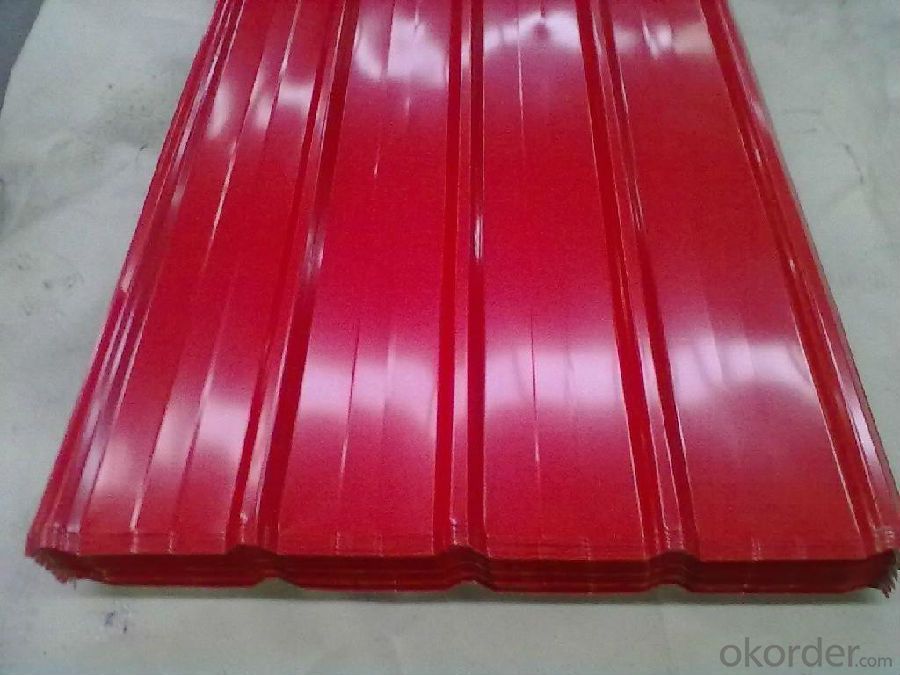
Specifications of Hot Rolled Steel Billet 3SP Standard 160mm
Product | Hot Rolled Steel Billet 3SP Standard 160mm |
Material Grade | SGCC / SGCH / DX51D+AZ, etc |
Thickness | 0.5-3.0mm |
Width | 700-1500mm |
Tolerance | Thickness: +/-0.02mm , Width:+/-2mm |
Zinc-coating | AZ30-150g/m2 |
Technique | Raw material: Hot rolled steel coil --> Cold rolled_>hot dipped galvalume |
Surface | Dried, Chromated, Unoiled,RAL Scale Z35 Prepainted Rolled Steel Coil for Construction Roofing |
Spangle | Regular spangle , small spangle, zero spangle |
ID | 508MM 610MM |
Coil weight | 25MT max |
Export package | Cardboard inner sleeves, Waterproof paper, galvanized steel covered and steel strip packed |
FAQ of Hot Rolled Steel Billet 3SP Standard 160mm
We have organized several common questions for our clients,may help you sincerely:
1. What is the minimum order quantity ?
Our MOQ is 100 mt for each size each specification. Usually we can offer discount if can buy large QTY once. RAL Scale Z35 Prepainted Rolled Steel Coil for Construction Roofing
2. How long can we receive the product after ordering?
Our general delivery time is 30 days after confirmation, but so some special orders, we have offer special delivery time
3. How to guarantee the quality of the products?
We have established the international advanced quality management system ,every link from raw material to final product we have strict quality test;We resolutely put an end to unqualified products flowing into the market. At the same time, we will provide necessary follow-up service assurance.
4. What is the payment?
We accept T/T, L/C
- Q:How are steel billets used in the manufacturing of valves and pumps?
- Valves and pumps require steel billets, which are necessary raw materials in their manufacturing process. These billets are cast into specific shapes, typically squares or rectangles, and serve as the foundation for producing valves and pumps. To make valves, steel billets are first heated and then forged or rolled into the desired shape. The billets undergo various processes like cutting, drilling, and machining to create different valve components, including the body, bonnet, disc, stem, and seat. These components are then assembled to form the valve, which controls the flow of fluids or gases in a system. Similarly, in pump manufacturing, steel billets are heated and shaped to create essential parts such as impellers, casings, shafts, and housings. These parts are then assembled to construct a pump, responsible for transferring fluids or gases from one location to another. The use of steel billets in valve and pump manufacturing is crucial due to steel's inherent properties. Steel is highly valued for its strength, durability, and resistance to corrosion, making it ideal for applications in industries where valves and pumps face high pressures, temperatures, and corrosive environments. Moreover, steel's versatility allows manufacturers to customize valves and pumps in terms of size, shape, and specifications to meet the specific requirements of diverse industries and applications. This adaptability ensures that valves and pumps made from steel billets can perform reliably and efficiently in various environments and conditions. In conclusion, steel billets play a vital role in the manufacturing of valves and pumps. Through forging, shaping, and assembly processes, steel billets are transformed into essential components that constitute these crucial industrial devices. The use of steel guarantees the strength, durability, and corrosion resistance needed for valves and pumps to function effectively and endure demanding operational conditions.
- Q:What is the role of steel billets in the manufacturing of railway wheels?
- Steel billets are the starting material used in the manufacturing of railway wheels. They are heated and forged into the desired shape and dimensions, forming the solid base for the wheels. The billets undergo various processes such as rolling, machining, and heat treatment to ensure the wheels have the necessary strength, durability, and dimensional accuracy required for railway applications.
- Q:Are steel billets subject to any regulations or certifications?
- Yes, steel billets are subject to various regulations and certifications. These regulations and certifications ensure that the steel billets meet specific quality standards, safety requirements, and environmental regulations. Some common certifications include ISO 9001 for quality management systems, ISO 14001 for environmental management systems, and certifications from industry-specific organizations like the American Society for Testing and Materials (ASTM) or the International Organization for Standardization (ISO). Additionally, steel billets may need to comply with specific regulations in the country or region where they are produced or used, such as building codes or product safety regulations.
- Q:How do steel billets contribute to the manufacturing of industrial machinery?
- Steel billets are an essential raw material in the manufacturing of industrial machinery as they serve as the starting point for various components. These billets are used to forge or cast parts such as gears, shafts, frames, and other critical structural elements. The high strength and durability of steel make it ideal for withstanding the harsh operating conditions and heavy loads often encountered in industrial machinery. Additionally, the versatility of steel allows for the fabrication of complex shapes and sizes, ensuring precise and reliable performance in the machinery.
- Q:How does the market demand for steel billets fluctuate over time?
- The demand for steel billets in the market can change due to a variety of factors. One of the main drivers of demand is the overall state of the economy. When the economy is doing well, there is usually a higher demand for steel billets because they are an important raw material for industries like construction, automotive, and manufacturing. On the other hand, during economic downturns or recessions, the demand for steel billets tends to decrease as these industries reduce their production and investment. Another factor that can affect the market demand for steel billets is the construction industry. Projects related to infrastructure, real estate, and urbanization can increase the demand for steel billets, as they are necessary for building structures like buildings and bridges. Changes in government policies or regulations regarding infrastructure spending can also have an impact on the demand for steel billets. Furthermore, the automotive industry plays a significant role in the demand for steel billets. As the automotive sector grows or declines, the demand for steel billets used in the production of automobile parts and components can change accordingly. Global trade and international relations can also influence the market demand for steel billets. Factors like tariffs, trade agreements, and geopolitical tensions can affect the supply and demand dynamics, leading to fluctuations in demand. For example, increased protectionism or trade barriers can result in reduced demand for steel billets in certain markets. Lastly, technological advancements and changes in consumer preferences can have an impact on the demand for steel billets. For instance, the increased use of alternative materials like aluminum or composites in certain industries may decrease the demand for steel billets. Additionally, shifts in consumer preferences towards more sustainable or lightweight products can also affect the demand for steel billets. In conclusion, the demand for steel billets in the market can change due to factors such as economic conditions, construction industry activity, automotive industry trends, global trade dynamics, and technological advancements. It is important for market participants to understand these factors and their potential impacts in order to anticipate and adapt to changes in demand for steel billets.
- Q:What is the average cost of steel billets?
- The average cost of steel billets can vary depending on several factors such as the type of steel, market conditions, and global supply and demand. Steel billets are semi-finished metal products that are typically used as raw material for the production of various steel products. As of September 2021, the average cost of steel billets ranges from $400 to $600 per metric ton. However, it is important to note that this price can fluctuate significantly in response to factors such as changes in raw material costs (such as iron ore and scrap metal), energy prices, transportation costs, and market dynamics. Additionally, regional factors such as import tariffs, trade restrictions, and currency exchange rates can also impact the average cost of steel billets in specific countries or regions. It is always advisable to consult with industry experts, steel suppliers, or market reports to obtain the most accurate and up-to-date information on the current average cost of steel billets.
- Q:How are steel billets used in the production of agricultural harvesting equipment?
- Steel billets are a crucial component in the production of agricultural harvesting equipment due to their strength, durability, and versatility. These billets are typically used to create the main structural framework of various types of agricultural machinery, such as combine harvesters, threshers, and balers. One of the primary applications of steel billets in the production of agricultural harvesting equipment is in the construction of the machine's frame. The frame serves as the backbone of the equipment, providing stability and support for all other components. Steel billets are ideal for this purpose as they have high tensile strength, allowing them to withstand the heavy loads and stresses encountered during harvesting operations. Additionally, steel billets are also utilized to manufacture various critical components of agricultural machinery. For example, they are often used to produce cutting blades, augers, and conveyors, which are essential for efficiently harvesting and processing crops. Steel's excellent wear resistance and toughness make it an ideal material for these components, as they need to withstand the abrasion and impact caused by contact with crops and other debris. Furthermore, steel billets are commonly employed in the manufacturing of hoppers, chutes, and other storage and transportation systems within agricultural harvesting equipment. These components are responsible for collecting, sorting, and transferring harvested crops, and therefore need to be robust and reliable. Steel billets provide the necessary strength and rigidity to ensure the efficient handling and movement of agricultural products. In summary, steel billets play a vital role in the production of agricultural harvesting equipment. Their strength, durability, and versatility make them indispensable for creating the main structural framework, critical components, and storage systems of these machines. By utilizing steel billets, manufacturers can ensure the production of reliable and efficient agricultural machinery that can withstand the demanding conditions of harvesting operations.
- Q:How are steel billets used in the manufacturing of structural components?
- The manufacturing of structural components heavily relies on steel billets, which are an essential raw material. These billets, usually square or round in shape, are produced through continuous casting, a process that solidifies molten steel into a semi-finished product. After the formation of steel billets, they undergo further processing using different techniques like hot rolling, forging, or extrusion. Hot rolling includes heating the billets and passing them through a sequence of rollers to shape them into desired profiles, such as beams, channels, or angles. This method is crucial for achieving the necessary dimensions, strength, and surface finish. Forging is another technique employed with steel billets, involving heating the billets and shaping them using compressive forces. It is primarily used for manufacturing components that require enhanced strength and durability, like crankshafts, connecting rods, or turbine blades. Extrusion, on the other hand, is a specialized process that utilizes heated billets to create complex shapes by forcing them through a die. This technique is commonly utilized in the production of tubular components, such as pipes, tubes, or hollow sections. These components are extensively used in the construction of structures like bridges, buildings, or infrastructure. Steel billets play a critical role in the manufacturing of structural components by providing the necessary raw material that can be shaped using various fabrication techniques. Their adaptability and versatility make them an indispensable component in the construction industry, ensuring that buildings and structures possess the required strength and durability to withstand different loads and environmental conditions.
- Q:How do steel billets contribute to the manufacturing of sports equipment?
- Steel billets contribute to the manufacturing of sports equipment by providing a strong and durable material for various components. These billets are often used to create the frames, shafts, and other structural parts of sports equipment such as golf clubs, tennis rackets, and bicycles. The high strength and resilience of steel make it ideal for handling the rigorous demands of sports activities, ensuring that the equipment can withstand impact, vibrations, and repetitive use. Additionally, steel billets can be easily shaped and molded into different forms, allowing manufacturers to create customized designs that enhance performance and optimize weight distribution.
- Q:How are steel billets tested for strength?
- To ensure the quality and appropriateness of steel billets for different uses, they undergo various strength tests. One commonly employed method is the tensile strength test, which involves applying a controlled pulling force to a sample of the billet until it breaks. The maximum force exerted during this test determines the billet's tensile strength. Another crucial test is the hardness test, which evaluates the billet's resistance to indentation. This procedure utilizes a hardness tester that applies a known force to the billet's surface and measures the resulting indentation's depth. The hardness value obtained from this test aids in determining the billet's strength and its ability to endure wear and tear. Additionally, steel billets may also undergo impact testing, in which a pendulum strikes the billet, measuring the energy absorbed during fracture. This test assesses the billet's toughness and its capacity to withstand sudden shocks or impacts. Moreover, ultrasonic testing is frequently conducted to identify any hidden flaws or inconsistencies within the billet. This non-destructive testing method employs high-frequency sound waves to detect internal defects like cracks, voids, or inclusions that may weaken the billet and jeopardize its strength. By combining these tests with other quality control measures, steel billets are thoroughly examined for strength and suitability in various industrial applications, including construction, automotive, and manufacturing.
1. Manufacturer Overview |
|
|---|---|
| Location | |
| Year Established | |
| Annual Output Value | |
| Main Markets | |
| Company Certifications | |
2. Manufacturer Certificates |
|
|---|---|
| a) Certification Name | |
| Range | |
| Reference | |
| Validity Period | |
3. Manufacturer Capability |
|
|---|---|
| a)Trade Capacity | |
| Nearest Port | |
| Export Percentage | |
| No.of Employees in Trade Department | |
| Language Spoken: | |
| b)Factory Information | |
| Factory Size: | |
| No. of Production Lines | |
| Contract Manufacturing | |
| Product Price Range | |
Send your message to us
Hot Rolled Steel Billet 3SP Standard 160mm
- Loading Port:
- Shanghai
- Payment Terms:
- TT OR LC
- Min Order Qty:
- 100 m.t.
- Supply Capability:
- 10000 m.t./month
OKorder Service Pledge
OKorder Financial Service
Similar products
New products
Hot products
Related keywords
